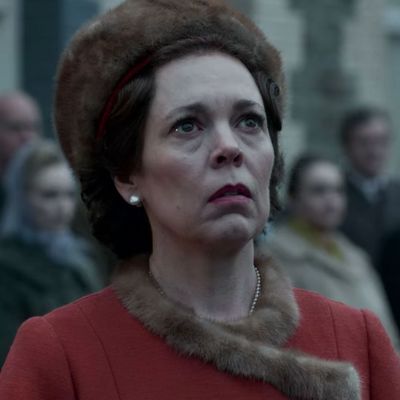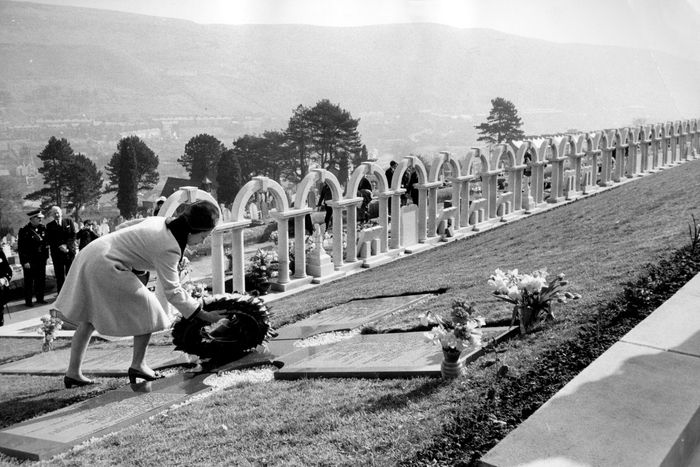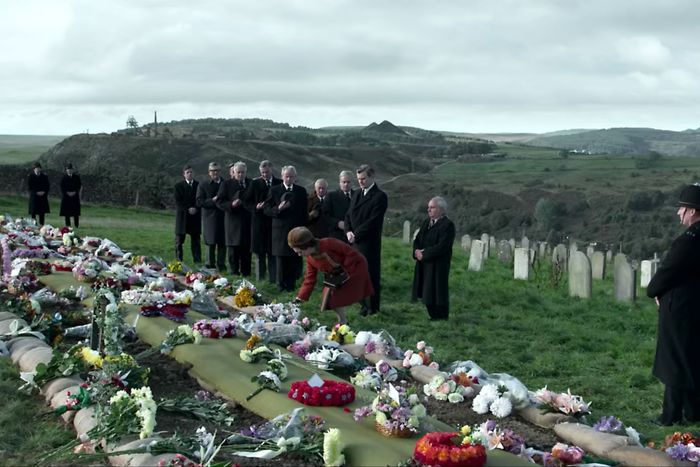
While historically based shows often play loose with facts, the subject of The Crown’s season-three episode “Aberfan” is all too real. In the episode, school children run outside in the rainy Welsh weather while a tall and forbidding hill of coal waste looms in the background. The next day, that hill collapses, sending around 300,000 cubic yards of coal slurry directly into the path of Pantglas Junior School and all the children and teachers inside.
The actual Aberfan disaster of October 21, 1966, killed 144 people; 116 of them were children. The Crown captures the awful scope of the tragedy — and how, infamously, Queen Elizabeth delayed her visit to Aberfan in the aftermath — but still, the story of the yearslong neglect that led to the disaster isn’t fully told.
What looks at first to be a Welsh mountain is in fact a spoil tip, a giant pile of accumulated waste material removed during mining. The mine in question, Merthyr Vale, was founded in 1869, and this particular tip had been created eight years earlier. Upon its collapse, 111 feet of extremely fine coal waste went crashing directly into Pantglas. If you’re wondering if anyone had voiced concerns over the danger of a spoil tip being located directly above a school — yes, they had. In 1963, just three years before the disaster, a letter was written to the National Coal Board discussing the “danger from coal slurry being tipped at the rear of the Pantglas Schools.” Although previous tip slides happened in 1944 and 1963, as of 1966, no colliery inspector had visited Aberfan in four years.
It all seems shocking: Multiple previous tip slides, public fears about the tip collapsing, and still no inspection of the mines? But when viewed in the context of Welsh mining in the 1960s, the reasons for the neglect become clear. At the time, oil was quickly outpacing coal as an energy source that was both cheap and plentiful. While the National Union of Mineworkers was strong, the number of miners shrank from 583,000 to 283,000 between 1960 and 1970. Approximately one mine was closing every nine days, and with them, people’s livelihoods. Miners, engineers, and others involved with Merthyr Vale were aware that if water got into the base of a spoil tip, it became unstable and could collapse — and the National Coal Board had placed this tip partly above underground water springs. Despite all this knowledge, it was not drained. In 1965, a senior Coal Board official claimed that if tipping ended, coal mining would end. This deliberate avoidance of the industry’s inevitable decline cost 144 people their lives.
Did Elizabeth II wait eight long days to visit Aberfan, like she does in The Crown? Yes. While the queen’s oft-portrayed personal diary is on display throughout the episode, her real diaries are private, and there is no way of knowing what she wrote or thought about in the days following the tragedy. Tony Snowdon drove down in the middle of the night, arriving at 2 a.m. Prince Philip came down the next day. The queen is reported to have initially resisted because of a worry that people would be looking after her instead of looking for the missing children. This concern is conveyed in “Aberfan,” along with the idea that the queen has a difficult if not impossible time feeling emotion, although the latter is obviously harder to factually corroborate.


While there are some reports that delaying her visit to Aberfan is the greatest regret in the queen’s life, survivors like Jeff Edwards, who was 8 years old when the disaster happened, harbor no blame: “She came when she could and nobody would condemn her for not coming earlier, especially as everything was such a mess,” he said in a 2002 interview.
In the aftermath of the disaster, a tribunal was held and the blame laid squarely on the National Coal Board, which was ordered to pay the victims’ families. (Their opening offer was £50, but they wound up paying £500 to each family.) Merthyr Vale itself stayed open a further 23 years until finally closing in 1989. The survivors of Aberfan were subsequently shown to suffer from PTSD, including nervousness, difficulty sleeping, and social isolation. The effects of this complete neglect of safety standards, down to a basic inspection, are thereby felt decades after the initial tragedy.
The queen has returned to Aberfan throughout her reign, including trips in 1973 to open a community center and in 1997, with Prince Philip, to plant a tree at the Aberfan Memorial Garden. In 2016, on the 50th anniversary of the disaster, she sent a note to the people of Aberfan: “I well remember my own visit with Prince Philip after the disaster, and the posy I was given by a young girl, which bore the heart-breaking inscription ‘From the remaining children of Aberfan’.”

